Tapas
| Origin | |
|---|---|
| Place of origin | Spain |
| Dish details | |
| Serving temperature | Warm or cold |
| Main ingredient(s) | Various |
Tapas (Spanish pronunciation: [ˈtapas]) is the name of a wide variety of appetizers, or snacks, in Spanish cuisine. They may be cold (such as mixed olives and cheese) or warm (such as chopitos, which are battered, fried baby squid). In select bars in Spain and maybe in North America or the United Kingdom, tapas has evolved into an entire, and sometimes sophisticated, cuisine. In Spain, patrons of Tapas can order many different tapas and combine them to make a full meal.
The serving of tapas is designed to encourage conversation because people are not so focused upon eating an entire meal that is set before them. Also, in some countries it is customary for diners to stand and move about while eating tapas.
Contents |
History
The word "tapas" is derived from the Spanish verb tapar, "to cover".
According to legend, the tapas tradition began when king Alfonso X of Castile recovered from an illness by drinking wine with small dishes between meals. After regaining his health, the king ordered that taverns would not be allowed to serve wine to customers unless it was accompanied by a small snack or "tapa."
According to The Joy of Cooking, the original tapas were the slices of bread or meat which sherry drinkers in Andalusian taverns used to cover their glasses between sips. This was a practical measure meant to prevent fruit flies from hovering over the sweet sherry. The meat used to cover the sherry was normally ham or chorizo, which are both very salty and activate thirst. Because of this, bartenders and restaurant owners began creating a variety of snacks to serve with sherry, thus increasing their alcohol sales.[1] The tapas eventually became as important as the sherry.
Tapas has evolved through Spanish history by incorporating ingredients and influences from many different cultures and countries. Most of the Iberian Peninsula was invaded by the Romans, who introduced the olive and irrigation methods. The invasion of the North African Moors in the 8th century brought almonds, citrus fruits and fragrant spices. The influence of their 700-year presence remains today, especially in Andalusia. The discovery of the New World brought the introduction of tomatoes, sweet and chili peppers, maize (corn), beans and potatoes. These were readily accepted and easily grown in Spain's microclimates.
Etymology
Tapa means "lid" or "cover" in Spanish. There are several explanations for why it has come to denote a type of food:
- A commonly cited explanation is that an item, be it bread or a flat card, etc., would often be placed on top of a drink to protect it from fruit flies; at some point it became a habit to top this "cover" with a snack.
- It is also commonly said that since one would be standing while eating a tapa in traditional Spanish bars, they would need to place their plates on top of their drinks in order to eat, making it a top.
- Some believe that the name originated sometime around the 16th century when tavern owners from Castilla-La Mancha found out that the strong taste and smell of mature cheese could help disguise that of bad wine, thus "covering" it, and started offering free cheese when serving cheap wine.
- Another popular explanation says that the king Alfonso XII stopped by a famous venta (inn) in Cádiz (Andalusian city) where he ordered a cup of sherry. The waiter covered the glass with a slice of cured ham before offering it to the king, to protect the wine from the beach sand, as Cádiz is a windy place. The king, after drinking the wine and eating the tapa, ordered another sherry "with the cover."
Spain
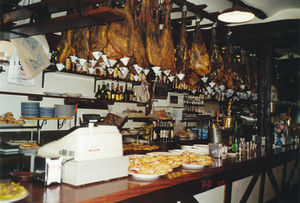
In Spain,[2] dinner is usually served between 9 p.m. and 11 p.m. (sometimes as late as 12 midnight), leaving significant time between work and dinner. Therefore, Spaniards often go "bar hopping" (Spanish: Ir de tapas) and eat tapas in the time between finishing work and having dinner. Since lunch is usually served between 1 and 3 p.m., another common time for tapas is weekend days around noon as a means of socializing before lunch proper at home.
It is very common for a bar or a small local restaurant to have 8 to 12 different kinds of tapas in warming trays with glass partitions covering the food. They are often very strongly flavored with garlic, chilies or paprika, cumin, salt, pepper, saffron and sometimes in plentiful amounts of olive oil. Often one or more of the choices is seafood (mariscos), often including anchovies, sardines or mackerel in olive oil, squid or others in a tomato based sauce, sometimes with the addition of red or green peppers or other seasoning. It is rare to see a tapas selection not include one or more types of olives, such as manzanilla or arbequina olives. One or more types of bread are usually available to eat with any of the sauce-based tapas.
In Madrid, Castilla-La Mancha, Castilla y León, Asturias, Extremadura, and in parts of Andalucia, when you go to a bar and order a drink, you will often get a tapa for free. As a drink, it is usual to ask for a caña (small beer), a chato (glass of wine) or a mosto (grape juice). In several cities, there are entire zones dedicated to tapas bars; each one serving their own unique dish. In León you can find the Barrio Húmedo, in Logroño Calle Laurel and in Burgos Calle de la Sombrerería and Calle de San Lorenzo.
Sometimes, especially in Northern Spain, they're also called pinchos (spelled pintxos in Basque) in Navarre, the Basque Country, Cantabria and in some provinces like Salamanca. They're called that because many of them have a pincho or toothpick through them. The toothpick is used to keep whatever the snack is made of from falling off the slice of bread it is attached to and to keep track of the number of tapas the customer has eaten. Differently priced tapas have different shapes or have toothpicks of different sizes. The price of a single tapa ranges from 1.00 to 2 euros. Another name for them is banderillas (diminutive of bandera "flag"), in part because some of them resemble the colorful spears used in bullfighting.
Tapas can be "upgraded" to bigger portions, equivalent to half a dish (media ración) or a whole one (ración). This is generally more economical when a tapa is being ordered by more than one person. The portions are usually shared by diners, and a meal made up of raciones resembles a Chinese dim sum, Korean banchan or Middle Eastern mezze.
Common Spanish tapas
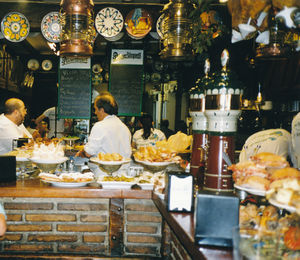
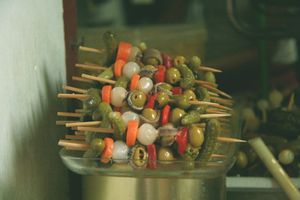
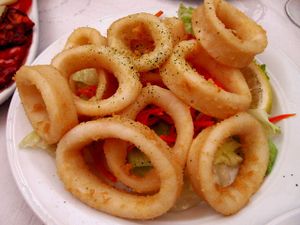
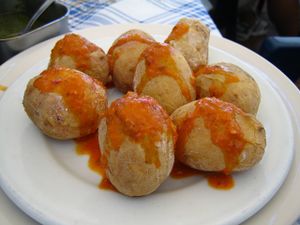
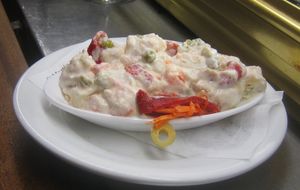
- Aceitunas
- Olives, sometimes with a filling of anchovies or red bell pepper.
- Albóndigas
- Meatballs with sauce.
- Alioli
- Means "Garlic and oil" in Catalan. The classic ingredients are only garlic, oil and salt, but the most common form of it includes mayonnaise and garlic. Served on bread or with boiled or grilled potatoes, fish, meat or vegetables.
- Bacalao
- Salted cod loin sliced very thinly usually served with bread and tomatoes
- Banderillas
- Banderillas, or pinchos de encurtidos, are cold tapas made out of small food items pickled in vinegar and skewered together. They are also known as gildas or piparras and consist of pickled items, like olives, baby onions, baby cucumbers, chillis (guindilla) with pieces of pepper and other vegetables. Sometimes they include an anchovy.[3]
- Boquerones
- White anchovies served in vinegar (boquerones en vinagre) or deep fried.
- Calamares or rabas
- Rings of battered squid.
- Carne mechada
- Slow-cooked, tender beef.[1]
- Chopitos
- Battered and fried tiny squid. Also known as puntillitas.
- Cojonuda (Superb female)
- A kind of "pincho". It consists of a slice of Spanish morcilla with a fried quail egg over a slice of bread. It is very common in Burgos, because the most well known and widespread Spanish morcilla is from there. It can also be prepared with a little strip of red spicy pepper.
- Cojonudo (Superb male)
- A kind of "pincho". It consists of a slice of Spanish chorizo with a fried quail egg over a slice of bread.
- Chorizo al vino
- Chorizo sausage slowly cooked in wine.
- Chorizo a la sidra
- Chorizo sausage slowly cooked in cider.
- Croquetas
- Croquettes are a common sight in bar counters and homes across Spain, served as a tapa, a light lunch, or a dinner along with a salad.
- Empanadas or empanadillas
- large or small turnovers filled with meats and vegetables.[4]
- Ensaladilla rusa
- This literally means (little) Russian salad and is made with mixed boiled vegetables with tuna, olives and mayonnaise.
- Gambas
- Prawns sauteed in salsa negra (peppercorn sauce), al ajillo (with garlic), or pil-pil (with chopped chili peppers).
- Mejillones rellones (Tigres)
- Stuffed Mussels. In Navarre, these stuffed mussels are called tigres ("tigers") because of their fieriness.
- Papas Arrugadas / Papas con Mojo
- Canary Islands: Very small new potatoes boiled in salt water similar to sea water, then drained, slightly roasted and served with Mojo sauce , a garlic, spanish paprika, red pepper, cumin seed, olive oil, wine vinegar, salt and bread "miga" (fresh bread crumbs without the crust) to thicken it.
- Pimientos de Padrón
- Small green peppers originally from Padrón (a municipality in the province of A Coruña, Galicia) that are fried in olive oil or served raw. Most are mild, but a few in each batch are quite spicy.
- Pulpo
- Pulpo means Octopus, and it is usually served in small chunks in the oil in which it was cooked. In its most basic form, salt is also added. Pulpo, as with many of Spain's seafood dishes, comes predominantly from Galicia due to the region's access to the rich resources of Atlantic Ocean.
- Pulpo a la gallega (Octopus the Galician way)
- This Galician dish, known both as Pulpo á galega (Octopus Galician style) and Polbo á feira (Octopus the trade fair style) in Galicia, is cooked in boiling water (preferably in a copper cauldron or pan) and served hot in olive or vegetable oil. The octopus pieces are seasoned with substantial amounts of paprika, giving it its recognisable red colour, and sea-salt for texture and flavour.
- Pincho moruno
- A stick with spicy meat, made of pork or chicken. Its name can translate to 'Moorish spike'.
- Patatas bravas
- Fried potato dices (sometimes par-boiled and then fried, or simply boiled) served with salsa brava, a spicy tomato sauce. Alioli is often served with it too.
- Puntillitas
- Battered and fried tiny squid. Also known as chopitos.
- Queso con anchoas
- Castilla or Manchego cured cheese with anchovies on top.
- Solomillo a la castellana
- Fried pork scallops, served with an onion and/or Cabrales cheese sauce
- Solomillo al whisky, or al güisqui
- Fried pork scallops, marinated using whisky, brandy or white wine and olive oil.
- Tortilla de patatas, also known as Tortilla española
- A type of omelet containing fried chunks of potatoes and sometimes onion. A variety containing vegetables and chorizo (similar to frittata) is known as Tortilla paisana.
- Tortillitas de camarones
- Battered-prawn fritters.
- Zamburiñas
- Most renowned from the region of Galicia, zamburiñas are Chlamys varia, a type of scallop, which are often served in a marinera, tomato-based sauce.
Regional variations
North America and the United Kingdom
Upscale tapas restaurants and tapas bars are common in many cities of the United States, Mexico, Canada, and the United Kingdom. As with any cuisine exported from its original country, there can be significant differences between the original Spanish dishes and the dishes as they are served abroad.
Venetian cicchetti
Cicchetti are small tapas-like dishes that are served in cicchetti bars in Venice. Venetians typically eat cicchetti for lunch or as late afternoon snacks.
Asia
In Japan, izakaya are drinking establishments that serve accompaniments which are similar to tapas.
In the Philippines, the term tapa, has little resemblance to the original Spanish meaning of the word. Rather, it is a traditional dish of salt-cured beef served at breakfast.
References
- ↑ Casas, P. (1985). Introduction. In Tapas, the little dishes of Spain (xv) [Introduction]. New York: Alfred A. Knopf.
- ↑ Rogers, J. (2000, February 23). Tapas reigning beyond Spain / take your pick. The Daily Telegraph, features f01. Retrieved September 17, 2008, from LexisNexis Academic database: http://0-www.lexisnexis.com.unistar.uni.edu/us/lnacademic/results/docview/docview.dostart=1&sort=RELEVANCE&format=GNBFI&risb=21_T4594338056
- ↑ Banderillas en vinagre
- ↑ Casas, P. (1985). Introduction. In Tapas, the little dishes of Spain (105) [Tapas with bread or pastry]. New York: Alfred A. Knopf
External links
- About.com Guide to Tapas in Spain.
- El mundo de las Tapas. History and recipes in Spanish and English
_004.jpg)